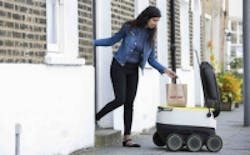Autonomous robot successfully delivers takeout for the first time
Navigating the sidewalks of London using a multi-component vision system, an autonomous robot developed by Starship Technologies has successfully delivered takeout to a customer in London, the first time such a task has been completed by a robot.
Just Eat, a UK food delivery service, sent the robot to Turkish restaurant Taksim Meze to pick up an order of falafel and lamb cutlets. The food then made its way back to the customer in a locked compartment in the robot, according to CNET.
First shown at the Mobile World Congress in February of 2016, the robot features a vision system comprised of multiple parts. The robot features a minimum of nine visible cameras, including three stereo pairs for a total of six visible spectrum cameras, along with three 3D Time of Flight cameras. It uses an Nvidia Tegra K1 mobile processor to perform machine vision and autonomous driving functions, as well as ultrasonic sensors with 360° view, and GPS and IMU / accelerometer. All of these components provide navigation, situational awareness, and reaction controls for the robot.
GPS on the robot is accurate to around 30 m, which the company says it not enough, so the robot utilizes computer vision algorithms to build a 3D map of the neighborhood before it can operate autonomously. Once the robot builds a map, it compares what it sees in its field of view to what it mapped previously, enabling the robot to know where it is located. In order to avoid obstacles, it has what Starship Technologies refers to as a ‘situational awareness bubble,’ which is created using the robot’s vision system and ultrasonic sensors. Topping out at only 4 mph, the robot is able to sense potential obstacles and stop at a safe distance.
Starship Technologies’ robot weighs nearly 40 lbs. and can hold around 22 lbs. in its empty compartment. Its battery lasts for two hours and it measures 27 x 22 x 22 in. (L x W x H), and its cargo bay measures 16 x 13.5 x 13 in. Additionally, the robot is able to go up curbs and has a braking distance of nearly 1 ft.
With a business headquarters in London and a research and development office in Estonia, the company has been testing its robots since the early part of 2016 in the US, UK, and Estonia, as well as 13 other countries. In July of 2016, the company launched a number of pilot programs with commercial partners testing the robots and robotic delivery platforms in Europe and the US.
Commercial deployments are planned for 2017. The company’s business model plan is to do last mile deliveries on behalf of partners or to help run a delivery service by providing robots as a ‘platform-as-a-service.’
View more information on Starship Technologies.
Share your vision-related news by contacting James Carroll, Senior Web Editor, Vision Systems Design
To receive news like this in your inbox, click here.
Join our LinkedIn group | Like us on Facebook | Follow us on Twitter
Learn more: search the Vision Systems Design Buyer's Guide for companies, new products, press releases, and videos
About the Author

James Carroll
Former VSD Editor James Carroll joined the team 2013. Carroll covered machine vision and imaging from numerous angles, including application stories, industry news, market updates, and new products. In addition to writing and editing articles, Carroll managed the Innovators Awards program and webcasts.
